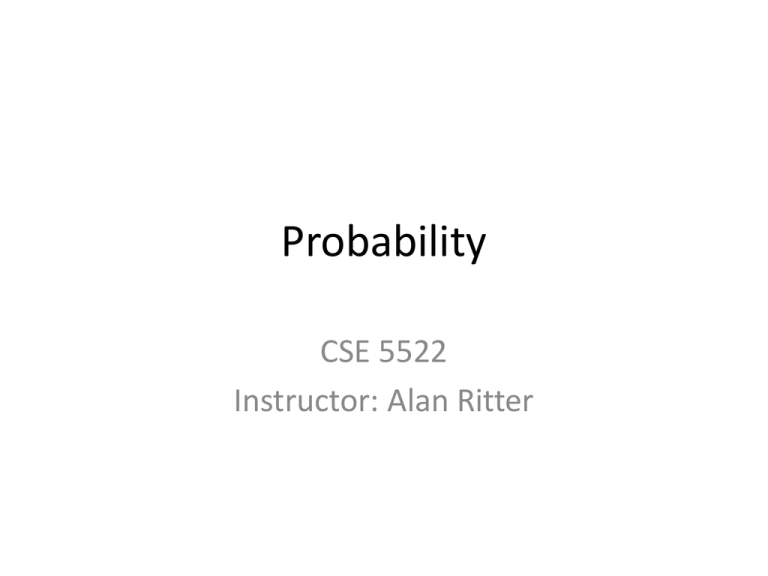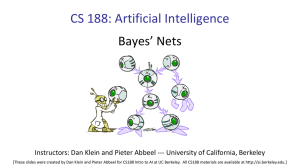Probability Theory Review
advertisement

Probability
CSE 5522
Instructor: Alan Ritter
What is Probability?
• “The probability the coin will land heads is 0.5”
– Q: what does this mean?
• 2 Interpretations:
– Frequentist (Repeated trials)
• If we flip the coin many times…
– Bayesian
• We believe there is equal chance of heads/tails
• Advantage: events that do not have long term frequencies
Q: What is the probability the polar ice caps will melt by 2050?
P r obabilit y basics
Begin with a set Ω—the sample space
e.g., 6 possible rolls of a die.
ω ∈ Ω is a sample point/ possible world/ atomic event
A probability space or probability model is a sample space
with an assignment P(ω) for every ω ∈ Ω s.t.
0 ≤ P(ω) ≤ 1
Σ ωP (ω) = 1
e.g., P(1) = P(2) = P (3) = P (4) = P (5) = P (6) = 1/ 6.
An event A is any subset of Ω
P(A) = Σ { ω∈A} P (ω)
E.g., P(die roll < 4) = P(1) + P (2) + P(3) = 1/ 6 + 1/ 6 + 1/ 6 = 1/ 2
R andom var iables
A random variable is a function from sample points to some range, e.g., the
reals or Booleans
e.g., Odd(1) = tr ue.
P induces a probability distribution for any r.v. X :
P(X = x i ) = Σ { ω:X (ω) = x i } P(ω)
e.g., P(Odd = tr ue) = P(1) + P(3) + P(5) = 1/ 6 + 1/ 6 + 1/ 6 = 1/ 2
Chapt er 13
8
P r op osit ions
Think of a proposition as the event (set of sample points)
where the proposition is true
Given Boolean random variables A and B :
event a = set of sample points where A(ω) = tr ue
event ¬a = set of sample points where A(ω) = f alse
event a ∧ b = points where A(ω) = tr ue and B (ω) = tr ue
Often in AI applications, the sample points are defi ned
by the values of a set of random variables, i.e., the
sample space is the Cartesian product of the ranges of the variables
With Boolean variables, sample point = propositional logic model
e.g., A = tr ue, B = f alse, or a ∧ ¬b.
Proposition = disjunction of atomic events in which it is true
e.g., (a ∨ b) ≡ (¬a ∧ b) ∨ (a ∧ ¬b) ∨ (a ∧ b)
⇒ P(a ∨ b) = P (¬a ∧ b) + P(a ∧ ¬b) + P(a ∧ b)
Chapt er 13
9
Sy nt ax for pr op osit ions
Propositional or Boolean random variables
e.g., Cavi ty (do I have a cavity?)
Cavi ty = tr ue is a proposition, also written cavi ty
Discrete random variables (finite or infinite)
e.g., W eather is one of ⟨sunny, r ai n, cloudy, snow⟩
W eather = r ai n is a proposition
Values must be exhaustive and mutually exclusive
Continuous random variables (bounded or unbounded)
e.g., Temp = 21.6; also allow, e.g., Temp < 22.0.
Arbitrary Boolean combinations of basic propositions
Chapt er 13
11
P r ior pr obabilit y
Prior or unconditional probabilities of propositions
e.g., P(Cavi ty = tr ue) = 0.1 and P (W eather = sunny) = 0.72
correspond to belief prior to arrival of any (new) evidence
Probability distribution gives values for all possible assignments:
P(W eather ) = ⟨0.72, 0.1, 0.08, 0.1⟩ (normalized, i.e., sums to 1)
Joint probability distribution for a set of r.v.s gives the
probability of every atomic event on those r.v.s (i.e., every sample point)
P(W eather, Cavi ty) = a 4 × 2 matrix of values:
W eather =
sunny r ai n cloudy snow
Cavi ty = tr ue 0.144 0.02 0.016 0.02
Cavi ty = f alse 0.576 0.08 0.064 0.08
Ever y quest ion ab out a dom ain can b e answer ed by t he j oint
dist r ibut ion because ever y event is a sum of sam ple p oint s
Chapt er 13
12
G aussian densit y
P (x) =
2
2
√ 1 e− (x− µ) / 2σ
2πσ
0
Chapt er 13
14
C ondit ional pr obabilit y
Conditional or posterior probabilities
e.g., P(cavi ty|toothache) = 0.8
i.e., given t hat toothache is all I know
N OT “ if toothache then 80% chance of cavi ty”
(Notation for conditional distributions:
P(Cavi ty|Toothache) = 2-element vector of 2-element vectors)
If we know more, e.g., cavi ty is also given, then we have
P(cavi ty|toothache, cavi ty) = 1
Note: the less specific belief r em ains valid after more evidence arrives,
but is not always useful
New evidence may be irrelevant, allowing simplification, e.g.,
P(cavi ty|toothache, 49er sW i n) = P(cavi ty|toothache) = 0.8
This kind of inference, sanctioned by domain knowledge, is crucial
Chapt er 13
15
I nfer ence by enum er at ion
Start with the joint distribution:
catch
L
catch catch
L
catch
toothache
L
toothache
.108 .012
.072 .008
cavity
.016 .064
.144 .576
L
cavity
For any proposition φ, sum the atomic events where it is true:
P(φ) = Σ ω:ω|= φP(ω)
Chapt er 13
17
I nfer ence by enum er at ion
Start with the joint distribution:
catch
L
catch catch
L
catch
toothache
L
toothache
.108 .012
.072 .008
cavity
.016 .064
.144 .576
L
cavity
For any proposition φ, sum the atomic events where it is true:
P(φ) = Σ ω:ω|= φP(ω)
P (toothache) = 0.108 + 0.012 + 0.016 + 0.064 = 0.2
Chapt er 13
18
I nfer ence by enum er at ion
Start with the joint distribution:
catch
L
catch catch
L
catch
toothache
L
toothache
.108 .012
.072 .008
cavity
.016 .064
.144 .576
L
cavity
For any proposition φ, sum the atomic events where it is true:
P(φ) = Σ ω:ω|= φP(ω)
P (cavi ty∨toothache) = 0.108+ 0.012+ 0.072+ 0.008+ 0.016+ 0.064 = 0.28
Chapt er 13
19
I nfer ence by enum er at ion
Start with the joint distribution:
catch
L
catch catch
L
catch
toothache
L
toothache
.108 .012
.072 .008
cavity
.016 .064
.144 .576
L
cavity
Can also compute conditional probabilities:
P(¬cavi ty ∧ toothache)
P(toothache)
0.016 + 0.064
=
= 0.4
0.108 + 0.012 + 0.016 + 0.064
P(¬cavi ty|toothache) =
Chapt er 13
20
N or m alizat ion
catch
L
catch catch
L
catch
toothache
L
toothache
.108 .012
.072 .008
cavity
.016 .064
.144 .576
L
cavity
Denominator can be viewed as a normalization constant α
P(Cavi ty|toothache) = α P (Cavi ty, toothache)
= α [P(Cavi ty, toothache, catch) + P(Cavi ty, toothache, ¬catch)]
= α [⟨0.108, 0.016⟩ + ⟨0.012, 0.064⟩]
= α ⟨0.12, 0.08⟩ = ⟨0.6, 0.4⟩
General idea: compute distribution on query variable
by fixing evidence variables and summing over hidden variables
Chapt er 13
21
I nfer ence by enum er at ion, cont d.
Let X be all the variables. Typically, we want
the posterior joint distribution of the query variables Y
given specific values e for the evidence variables E
Let the hidden variables be H = X − Y − E
Then the required summation of joint entries is done by summing out the
hidden variables:
P(Y |E = e) = αP (Y , E = e) = α Σ h P(Y , E = e, H = h)
The terms in the summation are joint entries because Y , E, and H together
exhaust the set of random variables
Obvious problems:
1) Worst-case time complexity O(dn ) where d is the largest arity
2) Space complexity O(dn ) to store the joint distribution
3) How to find the numbers for O(dn ) entries???
Chapt er 13
22
I ndep endence
A and B are independent iff
P (A|B ) = P(A) or P(B |A) = P (B ) or P(A, B ) = P (A)P(B )
Cavity
Toothache
Catch
Cavity
decomposes into Toothache Catch
Weather
Weather
P (Toothache, Catch, Cavi ty, W eather )
= P(Toothache, Catch, Cavi ty)P(W eather )
32 entries reduced to 12; for n independent biased coins, 2n → n
Absolute independence powerful but rare
Dentistry is a large field with hundreds of variables,
none of which are independent. What to do?
Chapt er 13
23
C ondit ional indep endence
P (Toothache, Cavi ty, Catch) has 23 − 1 = 7 independent entries
If I have a cavity, the probability that the probe catches in it doesn’t depend
on whether I have a toothache:
(1) P(catch|toothache, cavi ty) = P(catch|cavi ty)
The same independence holds if I haven’t got a cavity:
(2) P(catch|toothache, ¬cavi ty) = P (catch|¬cavi ty)
Catch is conditionally independent of Toothache given Cavi ty:
P(Catch|Toothache, Cavi ty) = P(Catch|Cavi ty)
Equivalent statements:
P(Toothache|Catch, Cavi ty) = P(Toothache|Cavi ty)
P(Toothache, Catch|Cavi ty) = P(Toothache|Cavi ty)P(Catch|Cavi ty)
Chapt er 13
24
C ondit ional indep endence cont d.
Write out full joint distribution using chain rule:
P(Toothache, Catch, Cavi ty)
= P(Toothache|Catch, Cavi ty)P(Catch, Cavi ty)
= P(Toothache|Catch, Cavi ty)P(Catch|Cavi ty)P(Cavi ty)
= P(Toothache|Cavi ty)P(Catch|Cavi ty)P(Cavi ty)
I.e., 2 + 2 + 1 = 5 independent numbers (equations 1 and 2 remove 2)
In most cases, the use of conditional independence reduces the size of the
representation of the joint distribution from exponential in n to linear in n.
Condit ional indep endence is our m ost basic and r obust
for m of knowledge ab out uncer t ain envir onm ent s.
Chapt er 13
25
B ayes’ R ule
Product rule P(a ∧ b) = P(a|b)P (b) = P (b|a)P(a)
⇒ Bayes’ rule P (a|b) =
P (b|a)P(a)
P (b)
or in distribution form
P(Y |X ) =
P(X |Y )P(Y )
= αP (X |Y )P (Y )
P (X )
Useful for assessing diagnostic probability from causal probability:
P(Cause|E f f ect) =
P(E f f ect|Cause)P(Cause)
P (E f f ect)
E.g., let M be meningitis, S be stiff neck:
P(m|s) =
P(s|m)P(m) 0.8 × 0.0001
=
= 0.0008
P (s)
0.1
Note: posterior probability of meningitis still very small!
Chapt er 13
26
B ayes’ R ule and condit ional indep endence
P(Cavi ty|toothache ∧ catch)
= α P(toothache ∧ catch|Cavi ty)P(Cavi ty)
= α P(toothache|Cavi ty)P(catch|Cavi ty)P(Cavi ty)
This is an example of a naive Bayes model:
P(Cause, E f f ect 1, . . . , E f f ect n ) = P (Cause)Πi P (E f f ect i |Cause)
Cavity
Toothache
Cause
Catch
Effect 1
Effect n
Total number of parameters is linear in n
Chapt er 13
27







